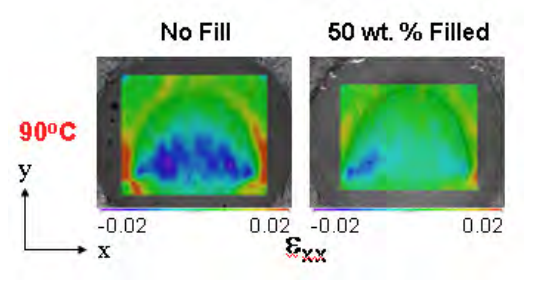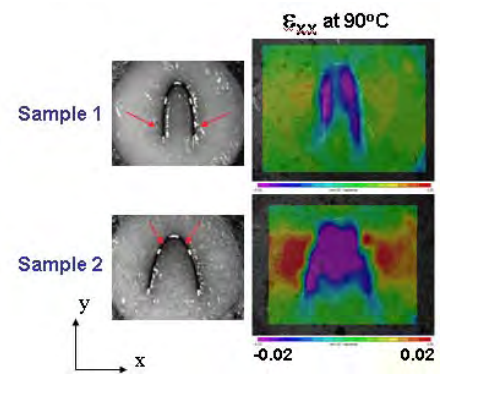![]() Health Management of Energetics
Health Management of Energetics
PI: Prof. Hugh Bruck
In-situ mechanical characterization
We have developed a technique for characterizing the mechanical behavior of energetic materials using using in-situ loading with embedded SMA actuators and in-situ strain sensing with integrated Fiber Bragg Grating (FBG) optical strain sensors. A thermomechanical treatment and prestrain for the SMA strain sensor has been investigated inorder to control the level of load applied to the energetic material when it is heated. The corresponding loading and response of the energetic material has been characterized using 2-D Digital Image Correlation (DIC), a full-field optical measurement technique. A FBG has then been explored for integration directly with the energetic material and integrated directly to the SMA actuator. The resulting output from the FBG is directly related to the level of loading that has the SMA actuator has been engineered for, and the corresponding deformation response of the energetic material that is related to its mechanical properties. Deterioration in the mechanical properties will result in significantly greater deformation response and output from the FBG. Thus, the output can be directly related to the state of health for the energetic material.
Engineering of SMA actuator
The thermomechanical treatment of the SMA actuator involves shaping of the SMA with a mold, and then holding that shape at a specified temperature and time. The SMA actuator and then be prestrained to a desired level that will be recovered upon heating generating load on the energetic material when the SMA is embedded in it. The temperature at which the loading occurs depends on the composition of the SMA. For these investigations, an SMA ribbon with an actuation temperature of 70°C was chosen. It was shaped into an Ushape geometry during thermomechanical treatment, and then bent after treatment to induce prestrain. The resulting deformation measured with DIC for two different levels of filler can be seen below. The removal of filler is equivalent to deterioration in mechanical properties due to aging, and demonstrates that the SMA actuator can be engineered to a loading level that has sufficient differences in deformation response in the energetic material to be detected by the FBG.

The ability to control the level of loading through prestrain can be seen in the figure below for two different levels of prestrain.

Integration of FBG
To integrate the FBG, two different cases have been investigated. First, the FBG has been attached directly to the energetic material in the region where the maximum strain has been detected by DIC. The second was to attach it directly to the SMA to measure the change in bending. Initial results have indicated that the FBG attached to the SMA can produce a much larger output than attached to the energetic material, making it the more suitable method for increasing measurement accuracy.

